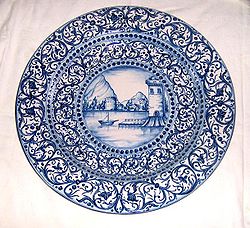- Majolica
-
Majolica, an English version of the Italian word maiolica, is a term covering a wide variety of European tin-glazed pottery, typically brightly painted over an opaque white background glaze, with an earthenware body.
The term was first used of Maiolica, luxury ceramics from Renaissance Italy, which continued to be made there in increasingly cheap and popular forms, and spread to several other European countries, some of which are known as faience. Delftware from the Netherlands and English Staffordshire ware are other local descendents, not usually known as majolica. In the 19th century there was a revival of luxury forms, known in English-speaking countries as Victorian majolica, with much use of moulded surfaces as well as colourful glazes. Popular and folk forms have continued in many countries, including the Mexican Talavera majolica.
Name
The name is thought to come from the medieval Italian word for Majorca, an island on the route for ships bringing Hispano-Moresque wares from Valencia to Italy. An alternative explanation of the name is that it comes from the Spanish term obra de Malaga, denoting “wares from/in the style of Malaga”, which continued to be used for Hispano-Moresque ware long after the industry had transferred to the area round Valencia, or obra de mélequa, the Spanish name for luster.[1]
In the 15th century, the term maiolica referred solely to lusterware, including both Italian-made and Spanish imports, and tin-glaze wares were known as bianchi (white ware).[1] Eventually the term came to be used when describing ceramics made in Italy, lustered or not, of tin-glazed earthenware, and then those from other countries. With the Spanish conquest of Mexico, tin-glazed maiolica wares came to be produced in the Valley of Mexico as early as 1540, at first in imitation of tin-glazed pottery imported from Seville.[2]
Today in English "maiolica" is generally used to describe the finer and earlier wares, and "majolica" for those from the 19th century onwards, though usage varies.
References
Categories:
Wikimedia Foundation. 2010.

